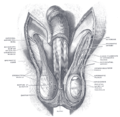Spermatic cord
Spermatic cord
The spermatic cord is a component of the male reproductive system, which extends from the abdominal inguinal ring down to the testis. It is made up of various structures, including the ductus deferens, testicular artery, pampiniform plexus, and autonomic nerves, among others.
Anatomy[edit]
The spermatic cord begins at the deep inguinal ring and extends to the testis. It is covered by layers of fascia derived from the layers of the anterior abdominal wall. The cord contains the ductus deferens, testicular artery, pampiniform plexus, autonomic nerves, and lymphatic vessels. The cremaster muscle is also contained within the spermatic cord.
Function[edit]
The primary function of the spermatic cord is to provide a conduit for structures to and from the testis. The ductus deferens transports sperm from the epididymis in anticipation of ejaculation. The testicular artery, a branch of the abdominal aorta, provides blood supply to the testis. The pampiniform plexus is a network of veins responsible for the venous drainage of the testis, and also plays a role in temperature regulation of the testis. The autonomic nerves provide innervation to the testis.
Clinical significance[edit]
The spermatic cord is susceptible to various pathologies, including torsion, varicocele, and indirect inguinal hernia. Torsion of the spermatic cord can lead to testicular ischemia and is a surgical emergency. Varicocele is a condition characterized by dilated veins of the pampiniform plexus, and is a common cause of male infertility. Indirect inguinal hernia occurs when a part of the intestine protrudes through the inguinal canal, which houses the spermatic cord.
See also[edit]
Ad. Transform your life with W8MD's Budget GLP-1 injections from $75


W8MD offers a medical weight loss program to lose weight in Philadelphia. Our physician-supervised medical weight loss provides:
- Weight loss injections in NYC (generic and brand names):
- Zepbound / Mounjaro, Wegovy / Ozempic, Saxenda
- Most insurances accepted or discounted self-pay rates. We will obtain insurance prior authorizations if needed.
- Generic GLP1 weight loss injections from $75 for the starting dose.
- Also offer prescription weight loss medications including Phentermine, Qsymia, Diethylpropion, Contrave etc.
NYC weight loss doctor appointmentsNYC weight loss doctor appointments
Start your NYC weight loss journey today at our NYC medical weight loss and Philadelphia medical weight loss clinics.
- Call 718-946-5500 to lose weight in NYC or for medical weight loss in Philadelphia 215-676-2334.
- Tags:NYC medical weight loss, Philadelphia lose weight Zepbound NYC, Budget GLP1 weight loss injections, Wegovy Philadelphia, Wegovy NYC, Philadelphia medical weight loss, Brookly weight loss and Wegovy NYC
|
WikiMD's Wellness Encyclopedia |
| Let Food Be Thy Medicine Medicine Thy Food - Hippocrates |
Medical Disclaimer: WikiMD is not a substitute for professional medical advice. The information on WikiMD is provided as an information resource only, may be incorrect, outdated or misleading, and is not to be used or relied on for any diagnostic or treatment purposes. Please consult your health care provider before making any healthcare decisions or for guidance about a specific medical condition. WikiMD expressly disclaims responsibility, and shall have no liability, for any damages, loss, injury, or liability whatsoever suffered as a result of your reliance on the information contained in this site. By visiting this site you agree to the foregoing terms and conditions, which may from time to time be changed or supplemented by WikiMD. If you do not agree to the foregoing terms and conditions, you should not enter or use this site. See full disclaimer.
Credits:Most images are courtesy of Wikimedia commons, and templates, categories Wikipedia, licensed under CC BY SA or similar.
Translate this page: - East Asian
中文,
日本,
한국어,
South Asian
हिन्दी,
தமிழ்,
తెలుగు,
Urdu,
ಕನ್ನಡ,
Southeast Asian
Indonesian,
Vietnamese,
Thai,
မြန်မာဘာသာ,
বাংলা
European
español,
Deutsch,
français,
Greek,
português do Brasil,
polski,
română,
русский,
Nederlands,
norsk,
svenska,
suomi,
Italian
Middle Eastern & African
عربى,
Turkish,
Persian,
Hebrew,
Afrikaans,
isiZulu,
Kiswahili,
Other
Bulgarian,
Hungarian,
Czech,
Swedish,
മലയാളം,
मराठी,
ਪੰਜਾਬੀ,
ગુજરાતી,
Portuguese,
Ukrainian










